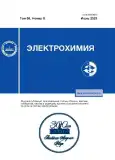卷 59, 编号 6 (2023)
The Effect of the Working Electrode Material Based on Pt/SnO2(Sb) on the Properties of Hydrogen and Carbon-Monoxide Sensors
摘要
The effect of the platinum content (3–10 wt %) in the Pt/SnO2(Sb)-based working-electrode material on the properties (sensitivity, high-speed performance, recovery time) of solid-state potentiometric gas sensors for hydrogen and carbon monoxide including their simultaneous presence in air is studied. Sensors with 5% Pt demonstrate the best characteristics: the efficient carbon-monoxide detection for its concentration from 0.01 to 1 vol %; no effect of hydrogen present in the CO + air mixture in concentrations comparable with the CO concentration; the shortest relaxation time (~30 s at 1% CO).
 333-341
333-341


Proton and Oxygen-Ion Conductivity of the Pure and Lanthanide-Doped Hafnates with Pyrochlore Structure
摘要
In this work, a high-density ceramics Ln2Hf2O7 (Ln = La, Nd, Sm, Eu, Gd) were synthesized by mechanical activation followed by high-temperature synthesis at 1600°C (3–10 h) and their transport properties were compared with those of Ln2.1Hf1.9O6.95 (Ln = La, Nd, Sm, Eu) doped solid solutions. The total conductivity of ceramics was studied using impedance spectroscopy and dc four-probe method; for Ln2Hf2O7 (Ln = Sm, Eu), by determining the total conductivity as a function of oxygen partial pressure. The maximum oxygen-ion conductivity was observed for Gd2Hf2O7 (~1 × 10–3 S/cm at 700°C); it was shown to approach the conductivity of Gd2Zr2O7 (~2 × 10–3 S/cm at 700°C) for the first time. Thus, the gadolinium hafnate can be a promising material for further doping in order to obtain highly conductive electrolytes. Among pure rare-earth hafnates, the proton conductivity was reliably observed for Nd2Hf2O7 only; however, ac measurements detected low-temperature proton conductivity in the Gd2Hf2O7 up to 450°С as well. With a decrease in the lanthanide ionic radius, the oxygen-ion conductivity increased in the Ln2Hf2O7 (Ln = La, Nd, Sm, Gd) series. Although the conductivity of samarium hafnate is an order of magnitude lower than that of Gd2Hf2O7, it has a wide range of oxygen-ion conductivity (~10–18–1 atm at 700, 800°C); there is no contribution from hole conductivity in air, in contrast to Eu2Hf2O7. Among doped Ln2.1Hf1.9O6.95 pyrochlore solid solutions (Ln = La, Nd, Sm, Eu), the proton conductivity of ~8 × 10−5 S/cm at 700°C was shown in Ln2.1Hf1.9O6.95 (Ln = La, Nd). With a decrease in the lanthanide ionic radius, the proton conductivity disappeared; the oxygen-ion one, increased.
 342-354
342-354


A New Desiccant Based on Graphene Oxide for Deep Dehydration of Electrolytes for Electrochemical Cells
摘要
A material based on graphene oxide is considered as a desiccant of aprotic solvents in nonaqueous electrolytes containing lithium salts. Three methods are proposed for preparation of final materials with different number and volume of pores. The effect of the initial parameters of hydrogel such as its pH and the concentration of solid substance is studied. Dependences of the adsorption capacity of desiccant on its porosity are plotted. The prospects of this new desiccant in dehydration of lithium electrolytes are discussed as compared with commercial molecular sieves.
 355-359
355-359


Electrochemical Oxygen Generator with Solid-Molten Bi2O3–B2O3 Electrolyte and Porous Bi3Ru3O11–Bi2O3 Electrodes
摘要
A symmetrical electrochemical cell Bi3Ru3O11−35 wt % Bi2O3 porous electrode|Bi2O3−0.2 wt % B2O3 solid-molten electrolyte|Bi3Ru3O11−35 wt % Bi2O3 porous electrode is developed. The values of the cell ohmic and polarization resistances, Faraday efficiency, and oxygen permeation flux of the cell were measured using impedance spectroscopy and Coulomb volumetric technique at 740°C. These values are 0.046 and 0.077 Ω cm2, 97%, and 5×10–7 mol cm–2 s–1, respectively. The effect of wetting of the porous electrode surface on the polarization resistance was analyzed. The Bi3Ru3O11−35 wt % Bi2O3 and solid-molten Bi2O3−0.2 wt % B2O3 composites have a great potential to be used as the electrode and electrolyte materials in electrochemical oxygen generators.
 360-366
360-366











